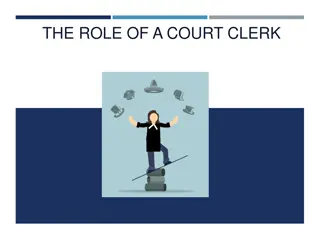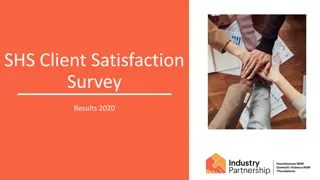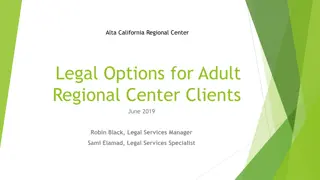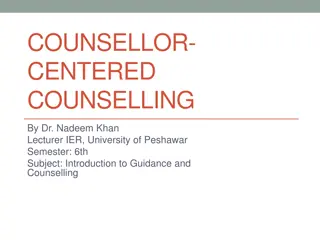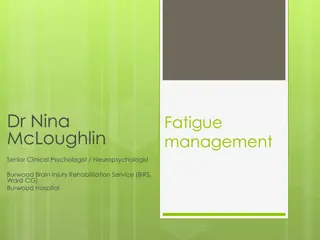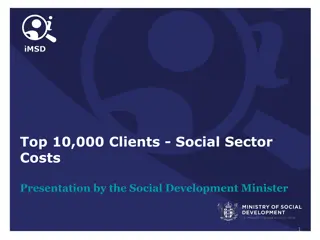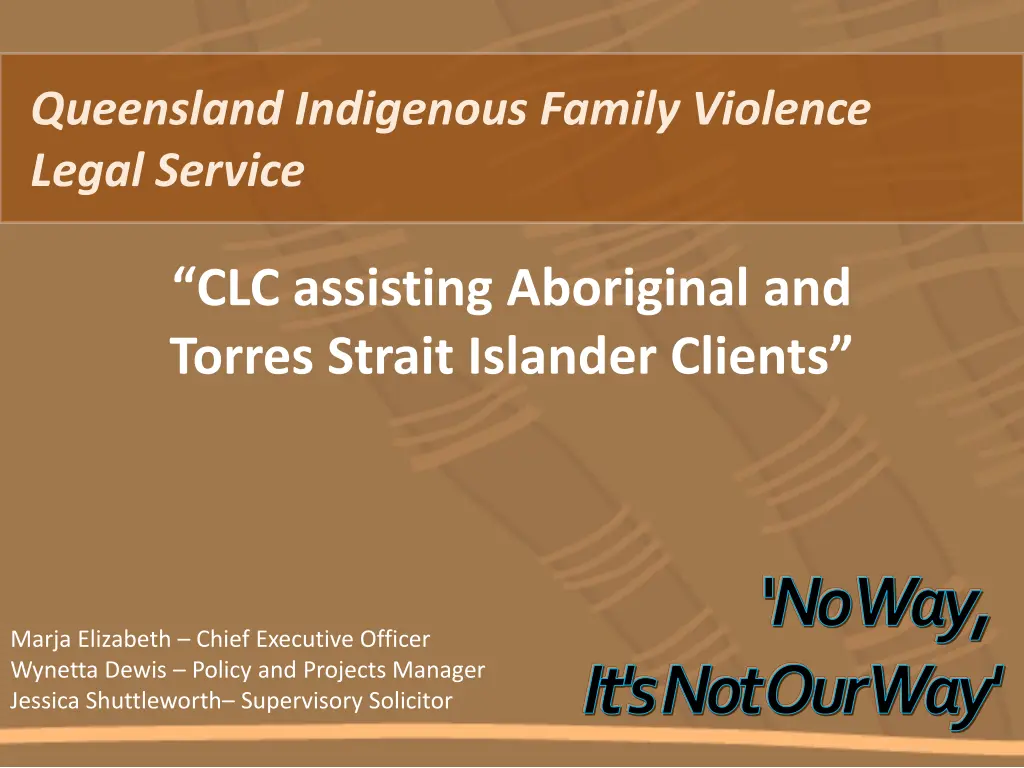
Queensland Indigenous Family Violence Legal Service Overview
"Learn about Queensland Indigenous Family Violence Legal Service (QIFVLS), dedicated to supporting Aboriginal and Torres Strait Islander communities in Queensland to live free from family violence and sexual assault. Explore their mission, service areas, client demographics, and organizational structure."
Download Presentation

Please find below an Image/Link to download the presentation.
The content on the website is provided AS IS for your information and personal use only. It may not be sold, licensed, or shared on other websites without obtaining consent from the author. If you encounter any issues during the download, it is possible that the publisher has removed the file from their server.
You are allowed to download the files provided on this website for personal or commercial use, subject to the condition that they are used lawfully. All files are the property of their respective owners.
The content on the website is provided AS IS for your information and personal use only. It may not be sold, licensed, or shared on other websites without obtaining consent from the author.
E N D
Presentation Transcript
Queensland Indigenous Family Violence Legal Service CLC assisting Aboriginal and Torres Strait Islander Clients No Way, Marja Elizabeth Chief Executive Officer Wynetta Dewis Policy and Projects Manager Jessica Shuttleworth Supervisory Solicitor
Our Vision Aboriginal and Torres Strait Islander people and communities in Queensland are supported to live free from family violence and/or sexual assault . Our Mission Address domestic and family violence and sexual assault of women, children and men by providing free legal and casework services and more broadly through community education, law reform and advocacy. Ensuring services are reflective of the cultural values of each community.
Service Areas Funded Areas Unfunded Service Areas Dajarra Normanton Aurukun Cairns Mareeba Bamaga Doomadgee Old Mapoon Atherton Seisa Bedourie Hope Vale Palm Island Ayr Townsville Birdsville Hughenden Pormpuraaw Biloela Tully Boulia Injinoo Richmond Bowen Woorabinda Brisbane (CBD) Julia Creek Rockhampton LGA Deeragun Yarrabah Burketown Kowanyama Umagico Djaringa Yeppoon Camooweal Lockhart River Urandangie Gladstone Charters Towers Mornington Island Weipa Home Hill Cloncurry Mount Isa LGA Wujul Wujul Ingham Coen (part) Napranum Innisfail Cooktown New Mapoon Kuranda
Origin 78.9% Aboriginal 12.9% Torres Strait Islander 8.2% Both Now servicing Brisbane CBD
By Air By Road Now servicing Brisbane CBD 2011 census 3.6% of the Qld population identify ATSI that is an increase of 22.1% since 2006. 34.2.% live in the Brisbane region 41.5% live in the regions from Cairns to Atherton, Townsville to Mackay and Rockhampton Two-thirds of the Aboriginal population of Australia live outside capital cities with 23% living in remote or very remote areas.
Organisational Structure The QIFVLS Board consists of eight Indigenous Regional Directors who are key community members from within our service areas. This ensures the service is Indigenous controlled, and that the communities can provide feedback through their local Board member. There are two Specialist Directors in the areas of Legal and Financial. Additional Regional Directors will be appointed for the Brisbane region.
Service Model Role of SoliCitor and Client Support Officer (CSO) CSO roles within the organisation are ATSI identified positions Client centred holistic support We provide practical and welfare support, court support and advocacy along with legal support and representation Culturally appropriate staff Cultural awareness training for all staff (indigenous and non- indigenous) Regular contact with communities to remain engaged and to keep abreast with what is happening in the communities
The average Aboriginal person has 70 discrete experiences of racism annually. 42% experience racism in their workplace. 79% of Aboriginal cope by avoiding situations where they predicted racism would occur. The more people in organisations that are cultural competent the less racist society becomes.
Cultural Competence Cultural awareness knowing Cultural sensitivity appreciating Cultural competence practising, demonstrating Cultural proficiency embedding as organisational practice Cultural competence must be obtained at both the individual and organisational levels in order to ensure effect practice with Aboriginal people.
How do you maintain a culturally appropriate service? Indigenous and non Indigenous staff Non tokenistic Indigenous roles Community Development Officer role/s Don t be culture blind when supervising Indigenous staff Cultural training as an ongoing Participation in community activities with all staff Cultural mentors from communities Cultural handbook Induction Specific training for Supervisors and Managers in how to supervise Indigenous staff Indigenous Board of Directors Board meetings across the state Connection with community from the Board down
Retaining Indigenous staff Family and cultural obligations Absenteeism for cultural reasons Humbugging Longing for country and cultural grieving Lack of career path Policies and procedures fail to take cultural differences into account e.g. cultural leave
In Australia, Indigenous women report a rate of family violence which is six times higher than that of non-Indigenous women. Indigenous people are less likely to take action on legal problems and consult on legal advice in remote areas i.e. 22.8% in major cities compared to 5.6% in remote areas. Indigenous women are 35.1 times as likely to be hospitalised as a result of family violence related assaults and are almost 10 times as likely to die as the result of assaults than non-Indigenous women. Indigenous women s imprison rate is 16.5 times that of general family population and higher then for Indigenous men which is (13.4 times).
Issues in servicing clients Impact of history and associated trauma Remoteness of communities Every community is different Don t assume literacy, numeracy, language and culture are an issue Facilities don t expect an office Complexity of legal issues with Indigenous clients Complexity of non legal issues Lack of education and access to basic services like health, therapy, food, government services particularly in remote areas Lack of choice of services remote versus urban Gender issues
Working with Indigenous clients Face to face in preference to telephone Advice and not action Understanding the different parenting styles of Indigenous people Family has a different/extended concept Role of support person Good communication English may not be the first language of clients Having someone who understands the language and can relay the legal terms (CSO) Body language, eye contact Engage by using visually based techniques
Working with Indigenous clients Yes might not mean yes Be flexible about where you meet not in offices Take time stories are often told narratively and with a lot of background Listen and don t speak too often Respect Expect long silences How to engage instant rapport Aboriginal language is relational rather then descriptive Non verbal communication is preferred voice tone, facial expression, eye movement
Indigenous parenting styles Aboriginal White Australian Child caring shared by the large extended family group. Children have the capacity to demand what they want i.e. cry if hungry. Nuclear family Child s mother with input from the father. Children seen as helpless. Children allowed to be independent in self care. Children not expected to be independent in eating, dressing or washing. Little oral obedience training. Oral obedience begins early e.g. No , stop . Competitive play not encouraged. Competition often encouraged. Sleeping can be in any room. Children accept responsibility for each other with no adults. Sleeping often away from family. Children expected to stay close to adults. Siblings mix but parents in charge. Children's possessions available to all and not really valued. Children have their own possessions and encouraged to look after them. Awareness of shame which often leads to withdrawal. More practical feelings and behaviours rather than shame.
Indigenous children are 8 times as likely to be the subject of substantiated child abuse and neglect; over 9 times as likely to be on care and protection orders and 10 times more likely to be in out of home care. FVPLS provide over 220 CLE annually to about 150 communities. 80% of Aboriginal women report that their offending is linked to family violence; 70% report having been sexually assaulted or having suffered other types of childhood abuse; while 44% report being sexually assaulted as adults. A large proportion of these women have also been in the child protection system or institutionalised. FVPLS services see over 5000 clients each year approximately 90% are women.
Community protocols/starting a service Connect with the traditional (TO s) / Elders. Understanding the difference between Aboriginal and Torres Strait Islander culture. Understanding each community is different. Build trust in the community and go slow (Yarrabah /Brisbane). Have a presence in the community not just fly in and fly out. Be prepared to get it wrong and take a growling. Vouching










